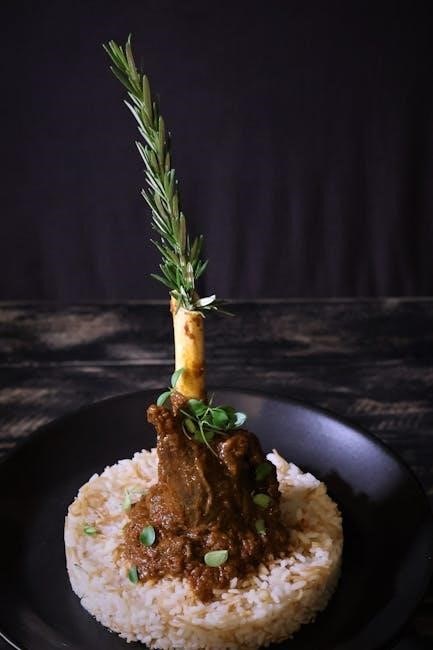
Brown jasmine rice is a fragrant, whole-grain rice variety native to Thailand, offering a nutty flavor and chewy texture. It is rich in nutrients and pairs well with diverse cuisines.
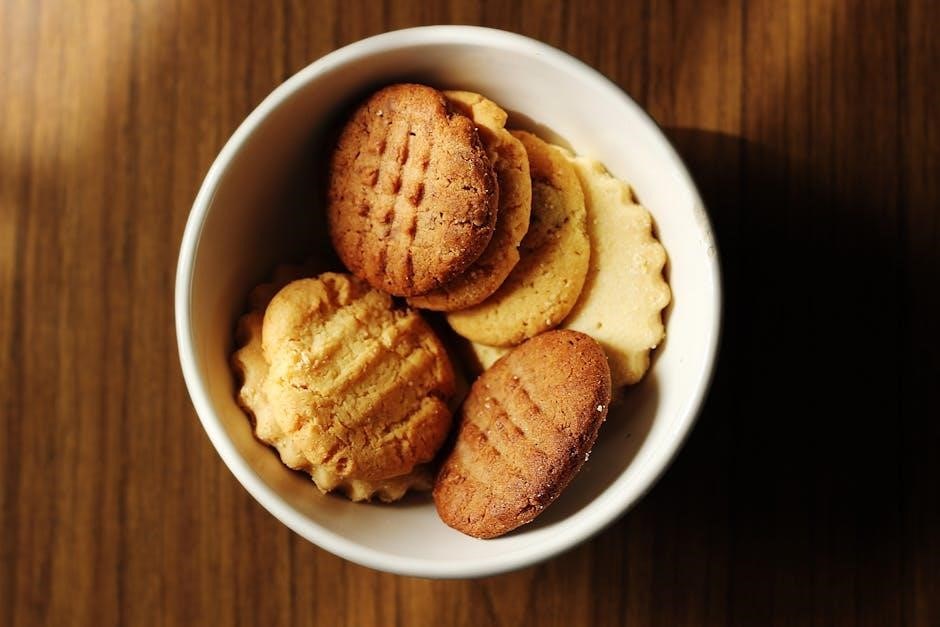
Benefits of Brown Jasmine Rice
Brown jasmine rice is a nutrient-rich, whole-grain option offering numerous health benefits. It is high in fiber, which aids digestion and promotes satiety. The rice is also packed with vitamins, minerals, and antioxidants, supporting overall well-being. Its nutty flavor and chewy texture make it a satisfying addition to meals. Brown jasmine rice is gluten-free, making it an excellent choice for those with dietary restrictions. It provides sustained energy due to its complex carbohydrates and has a lower glycemic index compared to white rice, benefiting blood sugar control. Additionally, it contains plant-based protein, supporting muscle health. Incorporating brown jasmine rice into your diet can enhance nutritional intake and provide a flavorful, wholesome alternative to refined grains.
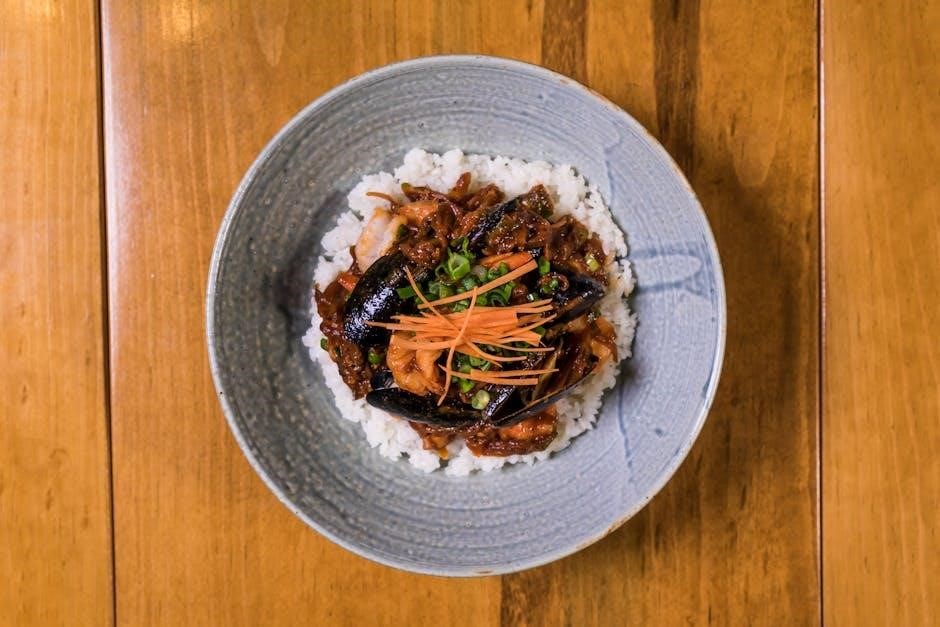
Ingredients and Tools Needed
To prepare brown jasmine rice, you’ll need 1 cup of brown jasmine rice, 2 cups of water, and a pinch of salt. Tools include a medium pot, a stove, a measuring cup, and a wooden spoon for fluffing.
Ingredients
To cook brown jasmine rice, you will need the following ingredients: 1 cup of brown jasmine rice, 2 cups of water, and a pinch of salt. The rice should be rinsed before cooking to remove excess starch and impurities. Using filtered water is recommended for better taste and to avoid any impurities in tap water. The salt is optional but enhances the flavor and helps in the cooking process. Ensure the water is fresh and cold when added to the rice for optimal hydration. These simple ingredients are all you need to prepare a delicious and nutritious batch of brown jasmine rice. The ratio of water to rice is crucial, with 2 cups of water for every 1 cup of rice, ensuring the rice cooks evenly and retains its signature chewy texture.
Tools
To successfully cook brown jasmine rice, you’ll need a few essential tools. A medium-sized saucepan with a heavy bottom and a tight-fitting lid is ideal for even heat distribution and retention. A fine-mesh strainer or a rice rinser is necessary for rinsing the rice thoroughly before cooking. Measuring cups (both dry and liquid) are crucial for accurately portioning the rice and water. A wooden or silicone spatula helps in gently fluffing the rice after cooking without breaking the grains. Optional tools include a rice cooker or Instant Pot for hands-off preparation, though they are not required. Ensure all tools are clean and dry before use to prevent any impurities or odors from affecting the rice. These tools will help you achieve perfectly cooked brown jasmine rice every time, regardless of the method you choose.
Preparation Steps
Rinsing, measuring, and heating are key steps. Rinse rice thoroughly, measure water accurately, and heat the pot properly to ensure even cooking and optimal texture.
Step 1: Rinsing the Rice
Rinsing brown jasmine rice is essential to remove excess starch, impurities, and debris. Place the rice in a fine mesh strainer and rinse under cold running water for about 30 seconds. Gently agitate the rice with your hands to ensure thorough cleansing. Continue rinsing until the water runs clear, which may take 2-3 rinses. This step helps reduce starchiness, preventing the rice from becoming sticky or clumpy during cooking. Proper rinsing also enhances the texture and flavor of the cooked rice. After rinsing, drain the rice thoroughly to remove excess moisture before proceeding to the next steps. This simple yet crucial step ensures the best results for your brown jasmine rice dish.

Step 2: Measuring the Water
Measuring the water accurately is crucial for perfectly cooked brown jasmine rice. Generally, use a 1:1.25 ratio of rice to water. For every 1 cup of rice, add 1.25 cups of water. Use a measuring cup to ensure precision. Pour the measured water into a pot, making sure it aligns with the recommended ratio. Avoid using too much water, as it can result in mushy rice, or too little, which may leave the rice undercooked. Once the water is measured, place the pot on the stove and prepare for heating; This step ensures the rice cooks evenly and retains its texture and flavor. Proper water measurement is key to achieving the desired consistency in your brown jasmine rice dish. Always double-check the measurements before proceeding to the next step.
Cooking Process
Cooking brown jasmine rice involves heating a pot, adding measured rice and water, seasoning, and simmering until the water is absorbed. Monitor the rice during cooking to ensure perfect texture and flavor.
Heating the Pot
To begin the cooking process, select a medium-sized saucepan with a heavy bottom, as this helps distribute heat evenly. Place the pot over medium heat on your stovetop. Add a small amount of oil or butter to the pot, if desired, to prevent the rice from sticking. Allow the pot to heat for about 2-3 minutes until it reaches the right temperature. You’ll know it’s ready when the pot feels hot but not smoking. This step ensures the rice cooks consistently and prevents burning. Once the pot is properly heated, you’re ready to add the rinsed rice and measured water.
Adding Rice and Water
Once the pot is heated, carefully pour in the rinsed brown jasmine rice. Add the measured water according to the recommended ratio (typically 1 3/4 cups of water for every 1 cup of rice). Gently stir the rice to ensure even distribution and to prevent clumps from forming. Avoid over-stirring, as this can damage the delicate grains. Bring the water to a boil, then reduce the heat to low. Cover the pot with a tight-fitting lid to trap steam and promote even cooking. Allow the rice to simmer undisturbed for about 15-20 minutes, or until all the water has been absorbed and the rice is tender. This step is crucial for achieving the perfect texture and flavor.
Seasoning
Lightly season the brown jasmine rice before or during cooking to enhance its natural flavor. Add a pinch of salt to the water for a subtle savory note. For extra depth, you can include a splash of olive oil, a squeeze of fresh lime juice, or a sprinkle of herbs like thyme or rosemary. If desired, mix in minced garlic or grated ginger for aromatic complexity. Stir gently to distribute the seasonings evenly. Avoid over-seasoning, as the rice should complement rather than overpower the accompanying dishes. Once seasoned, let the rice cook undisturbed with the lid on to allow the flavors to meld. Taste and adjust seasoning after cooking if needed. This step ensures the rice is not only nutritious but also bursting with delicious, balanced flavors that pair well with various cuisines.
Cooking
Once the pot is hot and the rice and water are added, reduce the heat to low and cover the pot with a tight-fitting lid. Allow the rice to simmer undisturbed for 15-20 minutes, or until all the water is absorbed. Avoid lifting the lid or stirring the rice during this time, as it can disrupt the cooking process. After 15 minutes, turn off the heat and let the rice rest, still covered, for an additional 5 minutes. This step allows the rice to steam and ensures a fluffy texture. Do not skip the resting period, as it is crucial for even cooking. Once the resting time is up, the rice is ready to be fluffed with a fork before serving. Proper cooking ensures the grains are tender and separate, with a creamy consistency.
Monitoring the Rice
During cooking, it’s important to monitor the rice to ensure it cooks evenly and doesn’t burn. After adding the rice and water, reduce the heat to low and cover the pot. Avoid stirring or lifting the lid frequently, as this can disrupt the cooking process. Instead, occasionally check for small holes forming on the surface of the rice, which indicate that the water is being absorbed evenly. If you notice the water evaporating too quickly, you may need to adjust the heat slightly. Once most of the water has been absorbed and the rice is nearly cooked, turn off the heat and let it rest. Proper monitoring ensures the rice cooks thoroughly without becoming mushy or undercooked. Patience is key to achieving the perfect texture.
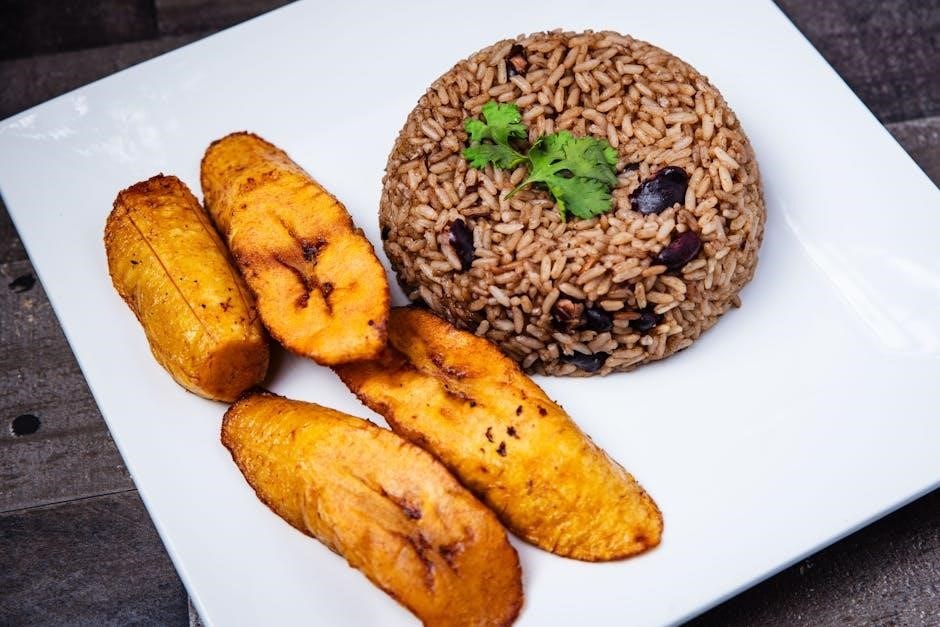
Completion and Serving
Once the rice is cooked, it’s ready to be served. Brown jasmine rice pairs perfectly with curries, stir-fries, or grilled meats. Garnish with fresh herbs or a squeeze of lemon for added flavor.
Rice is Done
When the rice is cooked, the water should be fully absorbed, and the grains will be tender but slightly firm. Turn off the heat and let it rest, covered, for 5 minutes. This step allows the steam to evenly distribute, ensuring fluffy texture. After resting, gently fluff the rice with a fork to separate the grains. Serve hot alongside your favorite dishes, such as curries, stir-fries, or grilled meats. For extra flavor, drizzle with a little sesame oil or soy sauce. Brown jasmine rice also pairs well with fresh herbs like mint or basil for a refreshing touch. Properly cooked rice should have a light, airy consistency and a nutty aroma, making it a perfect accompaniment to any meal.
Letting it Rest
After cooking, let the brown jasmine rice rest, covered, for 5-10 minutes. This crucial step allows excess moisture to evaporate and steam to redistribute, ensuring each grain is evenly cooked. Avoid lifting the lid during this time, as escaping steam can make the rice dry or uneven. Once rested, fluff gently with a fork to separate the grains. Resting enhances the texture, making the rice light and fluffy rather than clumpy. This method also helps retain the rice’s natural aroma and flavor, preparing it for serving. Proper resting ensures your dish is visually appealing and tastes its best. It’s a simple yet essential step in achieving perfectly cooked brown jasmine rice every time.
Fluffing the Rice
Fluffing brown jasmine rice is a crucial final step that ensures a light, airy texture. Use a fork to gently prong the rice, separating the grains without mashing them. Start from the top and work your way down, loosening any clumps formed during cooking. This step prevents the rice from becoming dense or sticky and enhances its natural fragrance. Fluffing also distributes heat evenly, helping any remaining moisture evaporate. Be gentle to avoid breaking the grains, which can make the rice mushy. Once fluffed, the rice should appear soft, separate, and ready to serve. Fluffing is essential for achieving the perfect texture and presentation, making it a must-do step before serving brown jasmine rice with your favorite dishes.
Serving Suggestions
Brown jasmine rice is a versatile base for countless dishes, complementing both savory and aromatic flavors. Serve it alongside Thai curries, stir-fries, or grilled meats for an authentic touch. For a healthier option, pair it with roasted vegetables or a fresh salad. It also pairs beautifully with Mediterranean dishes like hummus or tabbouleh. To enhance the meal, garnish the rice with fresh herbs like cilantro, basil, or mint, and drizzle with a light sauce or dressing. For a hearty breakfast, mix it with scrambled eggs, avocado, and chili flakes. Its nutty flavor makes it an excellent side for seafood, poultry, or beef. Whether you’re preparing a casual meal or a special occasion, brown jasmine rice adds a delightful and aromatic touch to any dish.
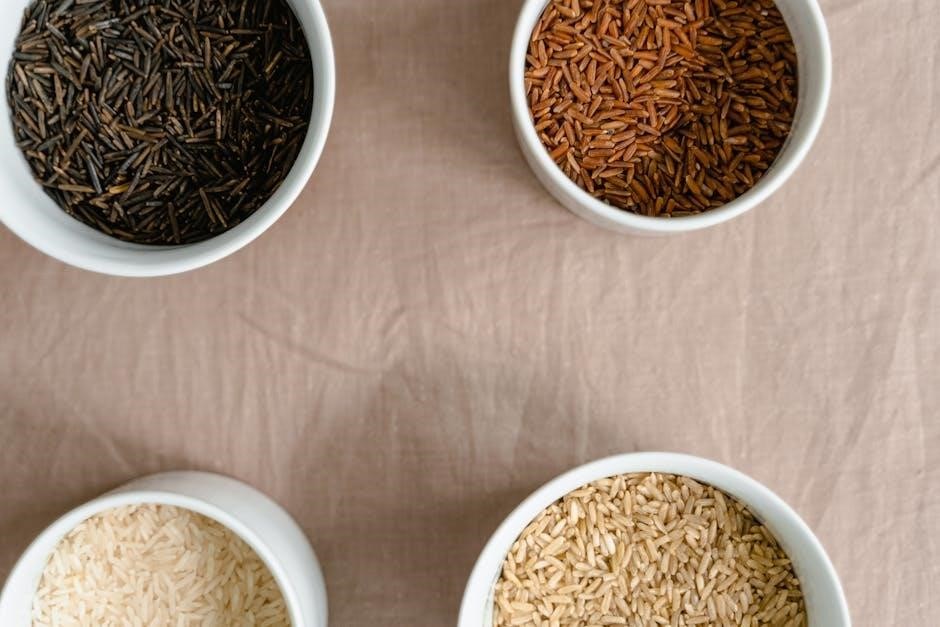
Storage and Reheating
To maintain the freshness of cooked brown jasmine rice, store it in an airtight container in the refrigerator for up to 5 days. For longer storage, place it in a freezer-safe container or bag and freeze for up to 3 months. When reheating, ensure the rice is cooled completely before storing to prevent moisture buildup. Reheat rice by steaming, microwaving, or pan-frying with a splash of water or broth to restore its texture. For best results, reheat only what you need, as multiple reheating cycles can dry out the rice. Always check for any signs of spoilage before consuming stored rice. Proper storage and reheating techniques help preserve the flavor and texture of brown jasmine rice for enjoyable meals throughout the week.
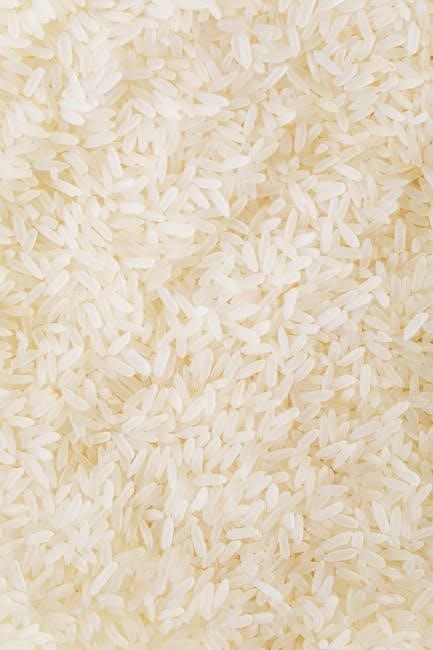
Tips for Perfect Cooking
For flawless brown jasmine rice, rinse it thoroughly before cooking to remove excess starch and impurities. Use a 1:1.25 rice-to-water ratio for optimal texture. Choose a heavy-bottomed pot to prevent burning and ensure even cooking. Add a pinch of salt or herbs during cooking for enhanced flavor. Avoid over-stirring, as this can break the grains. Once cooked, let the rice rest with the lid on for 5 minutes to allow steam to redistribute evenly. Fluff gently with a fork to maintain its fluffy texture. For drier rice, reduce water slightly, and for stickier rice, use a bit more. Don’t overcrowd the pot, as this can lead to uneven cooking. Use medium-low heat to prevent scorching. Experiment with broth instead of water for added flavor. Proper technique ensures perfectly cooked, aromatic brown jasmine rice every time.
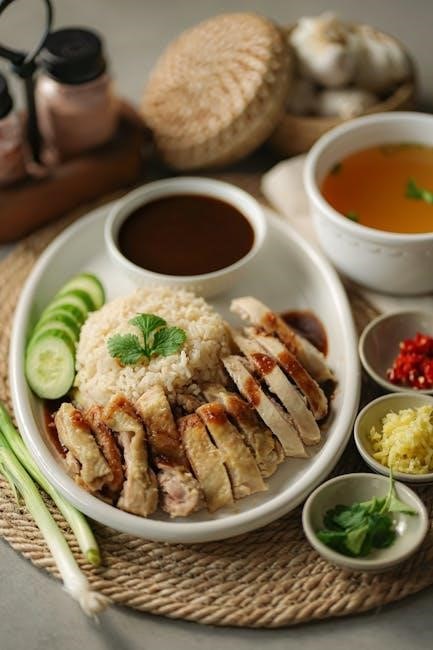
Variations and Alternatives
Try flavor infusions like coconut milk or herbs. Substitute with quinoa or wild rice for variety. Add spices or mix-ins like vegetables or nuts for a twist.
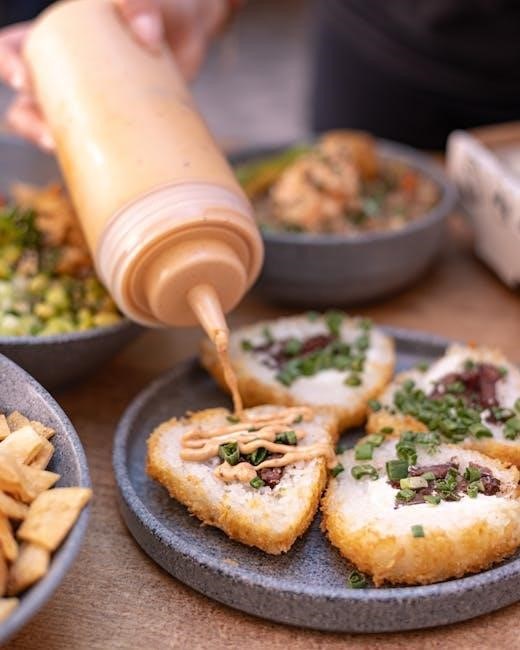
Using a Rice Cooker
Using a rice cooker simplifies the process of cooking brown jasmine rice. Rinse the rice thoroughly, then add it to the cooker with the recommended water ratio (1:1.25 for brown rice).
Add a drizzle of oil or a pinch of salt for enhanced flavor. Turn on the cooker and let it work automatically. Once done, let the rice rest for 5 minutes before fluffing.
This method ensures perfectly cooked, fluffy grains with minimal effort. Some cookers even have timers and non-stick coatings for convenience. Serve with your favorite dishes for a hearty meal.
Using an Instant Pot
Cooking brown jasmine rice in an Instant Pot is quick and efficient. Rinse the rice thoroughly, then add it to the pot with a 1:1.25 water ratio (1 cup rice to 1.25 cups water).
Add a tablespoon of oil or a pinch of salt for flavor. Turn on the sauté function to lightly toast the rice, then switch to manual mode. Cook on high pressure for 10-12 minutes.
Allow a 10-minute natural release before quick-releasing any remaining pressure. Let the rice rest for 5 minutes, then fluff with a fork. This method ensures tender, evenly cooked grains.
The Instant Pot’s pressure cooking feature helps retain nutrients and texture, making it ideal for perfectly cooked brown jasmine rice every time.
Health Considerations
Brown jasmine rice is a nutrient-rich whole grain, offering significant health benefits. It is high in fiber, which aids digestion and promotes satiety, making it an excellent choice for those managing weight or blood sugar levels.
The rice contains essential vitamins like B1 (thiamine) and minerals such as magnesium and manganese, supporting energy production and bone health. Its low glycemic index helps regulate blood sugar spikes, benefiting individuals with diabetes.
Choose organic or non-GMO options to avoid pesticides. For calorie-conscious diets, portion control is key, as brown jasmine rice is higher in calories than white rice. Pair it with lean proteins and vegetables for a balanced meal.
For those with dietary restrictions, it is gluten-free and suitable for vegetarians and vegans. However, rinse thoroughly to remove excess starch and arsenic, ensuring optimal nutritional value.
Cooking brown jasmine rice is a straightforward process that yields flavorful and nutritious results. By following the steps outlined, you can achieve perfectly cooked rice with a fragrant aroma and chewy texture.
This whole-grain rice is not only delicious but also packed with nutrients, making it a great addition to a healthy diet. Its versatility allows it to complement a wide variety of dishes, from savory meats to vegetarian meals.
Whether you’re a novice cook or an experienced chef, brown jasmine rice is a wonderful ingredient to work with. Experiment with different seasonings or cooking methods to enhance its natural flavor and keep your meals exciting.
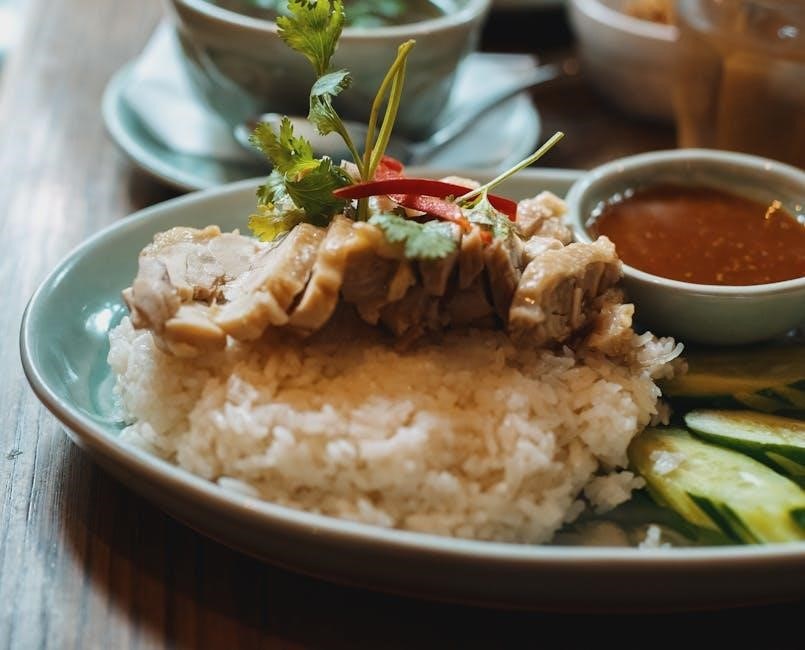
With proper storage and reheating techniques, you can enjoy brown jasmine rice anytime, making it a convenient and satisfying staple in your kitchen.